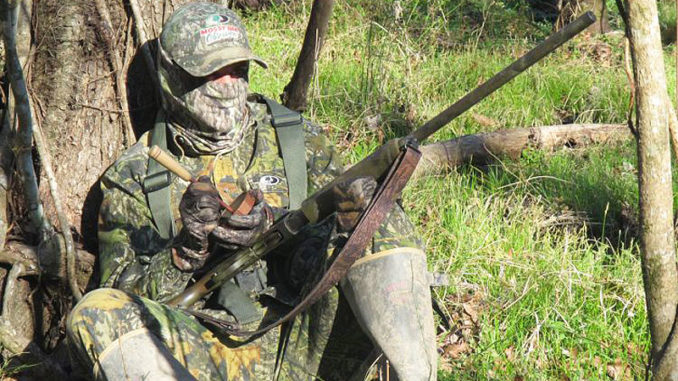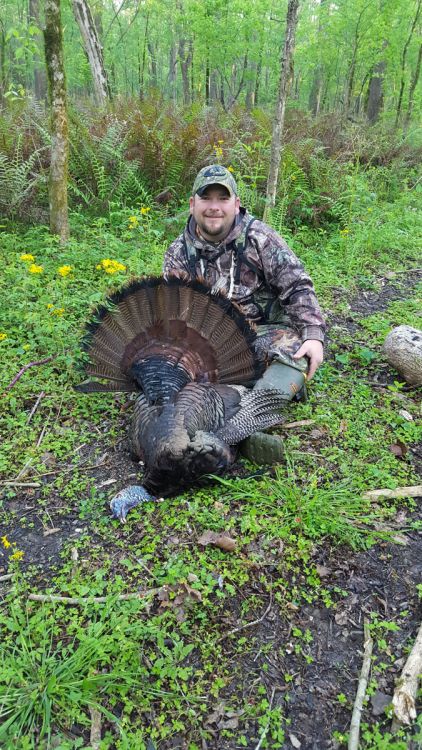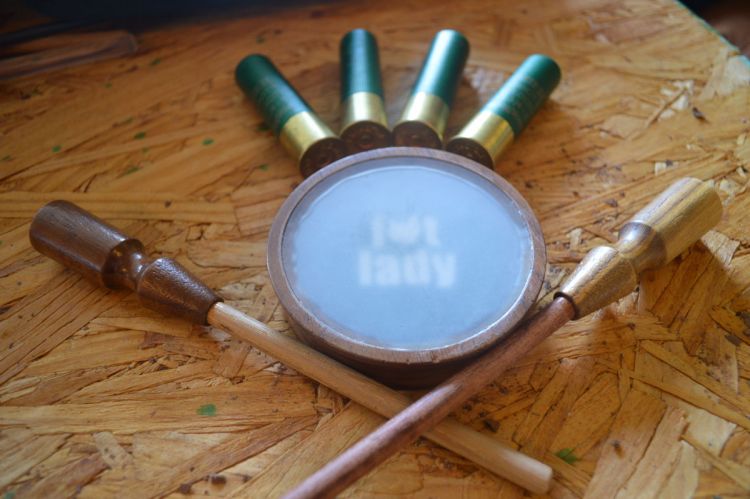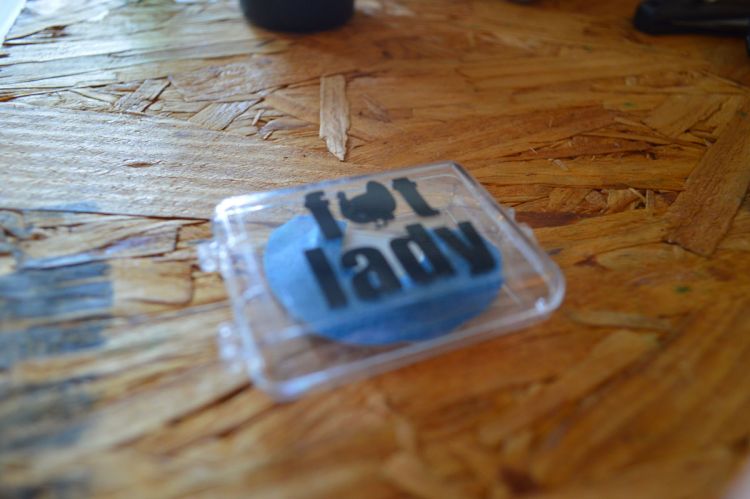
Sure, there are plenty of ways to call in a gobbler — but these proven tactics to kill will help you seal the deal.
It’s no small feat to actually come home with a wily, old gobbler. The bird’s eyesight alone makes it formidable quarry. Even when you’re covered head to toe in camouflage, the slightest mishap can ruin an otherwise solid hunt.
Perhaps that’s why there is such a dedicated group devoted to the sport, because to become a proficient turkey hunter you have to put in hard work and master the tools of the trade—the most important of which is the turkey call.
“It takes some time to learn how to call in a turkey,” said Jesse Langlois, who hunts near Butte La Rose. “If you think you’re not calling enough, you’re probably calling too much.
“It’s a delicate process.”
The hens do most of the work in the turkey woods. Sure, the gobbler calls at them from time to time, but does so only to round up the ladies. With all of the hens surrounding it, you’ve got a satisfied — and stubborn — tom on your hands.
The job of the hunter is to get the tom to come to him. “You’re trying to reverse Mother Nature,” said seven-time Louisiana turkey calling champion Bruce Saale. “When he’s got his hens around him, it can be pretty hard to do that.”
Saale, who owns Talkin’ the Talk Custom Calls, said that’s why a realistic sounding call is paramount. He said that gives a turkey hunter an advantage, as the more you can sound like the real thing, the better your chances are of harvesting a bird. “A call that sounds like a turkey, that’s better made and not out of plastic, is going to kill more birds,” he said.
While any hunt is about as predictable as a poker game, there are a few typical situations you might find yourself in. Here are four scenarios you may encounter this turkey season, and the steps you should take to kill a gobbler:
Henned up
A gobbler with plenty of hens is a hard one to harvest. It’s content and apt to tend to the flock it already has — meaning your calling may have less of an effect. You’ll know a gobbler is henned up when it will respond to your calling, but stays put. Saale said it’s saying, “Come to me.”

In this case, it’s best to get the attention of the dominant hen in the group. Start cutting aggressively, which might be enough to draw the hen away from the gobbler. If it approaches, so will the rest of the flock. In an effort to keep tabs on the hens, the gobbler might follow. “When that happens, it’s best to have a mouth call so you can remain still,” Saale said. “You don’t want to move with all those eyes on you.”
However, bringing in a hen doesn’t always work. Another proven tactic is to hunt later in the day. Langlois said to wait until between 9 a.m. and noon. “When the hens go dust or lay on their eggs later in the day, they leave the gobbler,” he said. “Then, you can putt and yelp and he’ll likely answer you.”
Other times, Langlois will wait two hours before dark until entering the woods again. If possible, he positions himself between the tom and its roost. “I’ll yelp every 10 minutes or so,” he said. “That makes him think one of his hens got separated from the rest and she’s not going to roost with the flock. Then he’ll come check out what’s going on.”
Pressured
Pressured turkeys can be found in just about any accessible parcel of public land in Louisiana. Langlois, who hunts pressured birds in the Atchafalaya Basin, said an over-hunted gobbler may sound off a time or two at first light. “With my mouth call, I’ll do a few yelps at him when I know he’s on the ground,” he said. “If he doesn’t respond, that means he’s been called in before and knows he’s being hunted. In that situation, I would go home and let him chill for a few days.”

When Langlois returns, he brings along a turkey wing. As the sun rises, he begins beating the wing on his leg, which mimics the sound of a hen flying down from its roost. “You want to hit it on the leaves, too, so it sounds realistic,” he said. “A lot of times he’ll gobble at that.”
While it may seem logical to call back then, Langlois said that’s where most hunters make a mistake. Instead, he scratches the leaves, which sounds like a hen dusting itself. That may be just enough to entice the gobbler off its roost. “A lot of times, that’s enough to bring in a tom close enough for a shot,” he said. “I won’t even have to pick up a call.”
However, Langlois said calling lightly can also work in this scenario. “Don’t call at him until he flies down,” he said. “Once you know he is on the ground, take a slate call and make some soft purrs and clucks. If he cuts them off with a gobble, he is interested.”
From there, Langlois said he stops calling — and plays the waiting game. Calling more can scare a wary gobbler away, while silence will actually bring it closer. “A turkey is hard-wired that when he gobbles, his hens are supposed to come to him,” he said. “When you get to calling and calling, he may be answering, but he’s saying, ‘Come to me.’”
After the prolonged silence, a gobbler is prone to“panic gobble,” which is when Langlois says the tom decides it should close the distance. As it approaches, you can gauge the location as it gobbles. Langlois said only then will he use a soft purr to coax it in. If the tom cuts its calling off, he stops again. “After that, you can put the calls in your bag and wait,” he said. “He’s on his way.”
Textbook
Of course, what every turkey hunter wants to see is a gobbler that responds well to calling and comes right in. Saale said these are typically 2-year-old toms, and you’ll find yourself in this situation at the beginning of the season, or on property where there isn’t a whole lot of pressure. “You’ll know you’ve got a responsive bird immediately,” Saale said. “He’ll gobble at everything and come right in.”

Once you’ve located a tom on its roost with a locator call, set up within 150 to 200 yards — any closer and you risk scaring the bird. After it flies down, start calling with a box or pot call, emitting clucks and then some purrs. An interested gobbler will call back almost immediately.
Langlois said he’ll sound off a series of yelps with his mouth call. “If he answers that, it’s time to stop calling,” he said. “He’s coming in and you can tell he’s getting closer from his gobbles. The next step is killing him.”
Hot
What sets a hot gobbler apart from a textbook one is how it reacts to being called. While a textbook bird will approach your direction even as you’ve stopped calling, a hot one is prone to lose interest.
The hunt starts off just like the textbook case. The gobbler will fly down off the roost and as you cluck and purr, it’ll respond, often gobbling and cutting off your calling. But, after an absence in your calling, if it seems to be farther away when it gobbles, you’ll have to continue calling. “It’s almost like you’re reeling him in,” Langlois said. “This scenario doesn’t happen often.”
After the next series of calls, the bird should have closed the distance. Continue the routine to coax it closer — call, listen to its response as it gets closer, then call again. Langlois said this is where he gets aggressive with his calling.
But when the gobbler is within 50 yards, that’s when you can stop calling so much. If it needs to be enticed in closer, make some soft purrs with a mouth call. At this point, Saale said you should be looking down the barrel. “When I see him, I’m not calling anymore,” he said. “I’m waiting for a shot to seal the deal.”


